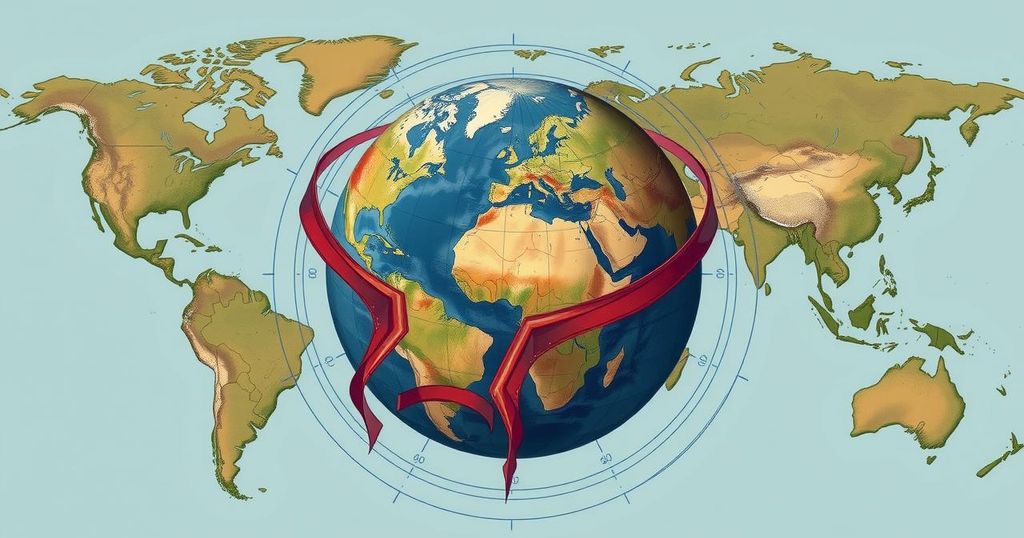Eight Countries Most Susceptible to Earthquakes Worldwide

This article examines eight countries prone to earthquakes, exploring their geographical vulnerabilities and the historical impact of seismic activities. It highlights Japan, Indonesia, Turkey, Greece, China, Iran, Mexico, and the United States as particularly affected by seismic events, discussing their mitigation strategies and the significance of their experiences in enhancing disaster preparedness.
Greece has recently declared a state of emergency in response to the ongoing seismic activity in Santorini, having experienced thousands of tremors, with over 200 being significant since late January. Situated on multiple fault lines, Greece is not alone in facing earthquake risks; numerous nations globally are similarly vulnerable. This article explores eight countries that are particularly earthquake-prone and examines the factors contributing to their seismic activity, along with the implications for their populations.
Japan is one of the most earthquake-prone nations, situated at the convergence of four major tectonic plates: Pacific, Philippine, Eurasian, and North American. Experienced annually, Japan records thousands of minor quakes, with catastrophic events like the 2011 Tōhoku earthquake and tsunami marking its seismic history. To mitigate damage, Japan has enacted stringent building regulations and established early warning systems.
Indonesia stands out as a focal point for seismic and volcanic activity due to its location on the Pacific Ring of Fire. The country is frequently struck by powerful earthquakes, often accompanied by tsunamis. Notably, the 2004 Indian Ocean earthquake and tsunami, originating near Sumatra, is recognized as one of history’s deadliest disasters, impacting millions across the region.
In Turkey, the North Anatolian Fault represents a significant seismic threat, placing major cities, including Istanbul, at risk. The tragic 1999 İzmit earthquake serves as a critical reminder of these dangers, resulting in over 17,000 fatalities and underscoring the urgent need for improved infrastructure and disaster preparedness throughout the country.
Greece’s geographical positioning at the intersection of the African and Eurasian plates makes it prone to frequent earthquakes. The seismic vulnerability of its islands, particularly Santorini and Crete, has been accentuated by recent tremors, which reflect Greece’s long-term earthquake risks and their historical influence on the nation’s architecture and landscape.
China’s substantial history of powerful earthquakes, particularly in its western and southwestern regions, has marked its seismic profile. The 2008 Sichuan earthquake, rated 7.9 on the Richter scale, resulted in nearly 90,000 deaths. The country’s susceptibility is linked to its location across multiple fault lines, notably those in the Himalayan seismic belt.
As one of the world’s most seismically active nations, Iran faces significant earthquake threats due to its position at the convergence of the Arabian and Eurasian plates. Several catastrophic events have been documented, including the deadly 2003 Bam earthquake that claimed over 26,000 lives. The impact of these earthquakes is often exacerbated by inadequate building infrastructure in certain areas.
Mexico’s position along the Pacific Ring of Fire renders it highly vulnerable to seismic events. The 1985 Mexico City earthquake, among the most devastating, highlighted this susceptibility, leading to substantial casualties and devastation. However, subsequent improvements in earthquake preparedness—such as advanced warning systems—have been instituted in response to these challenges.
In the United States, particularly in California and Alaska, the presence of the San Andreas Fault and other tectonic boundaries contributes to regular seismic activity. Historical events, including the 1906 San Francisco earthquake and the 1964 Great Alaska earthquake, remain notorious for their destruction. Though infrastructural enhancements have been made, these regions continue to face significant earthquake risks.
Earthquakes, caused by the sudden release of energy in the Earth’s crust, prominently occur in regions situated along tectonic plate boundaries. The severity and frequency of these seismic events are influenced by geographical features, underlying geological structures, and the historical context of each region. This article identifies countries particularly prone to earthquakes and discusses the geophysical characteristics contributing to their persistent seismic activity, as well as the ongoing challenges of disaster preparedness.
In summary, Greece, Japan, Indonesia, Turkey, China, Iran, Mexico, and the United States exemplify nations significantly impacted by seismic activity due to their geographical settings along major tectonic boundaries. Each of these countries experiences frequent and often devastating earthquakes, prompting varying degrees of infrastructure enhancements and disaster preparedness measures. Understanding these risks is essential for improving safety and resilience in the face of natural disasters.
Original Source: www.timesnownews.com







